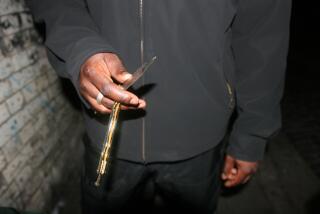Swordfish Off Hawaii Are Again Fair Game
- Share via
After a three-year shutdown, federal officials Tuesday reopened commercial swordfish operations off Hawaii, providing all U.S.-flagged boats use experimental fishing gear designed to reduce the inadvertent catch of endangered sea turtles.
The decision will allow dozens of boats to rejoin foreign vessels as part of the $300-million-a-year industry.
Swordfish fishermen from California, who are facing an impending ban off the state’s coastline, also will be eligible to fish Hawaiian waters as long as they use the new gear.
Virtually all swordfish are caught with long lines that are strewn with hooks and unfurled for 50 miles or more from the stern of a boat. Besides swordfish, the hooks catch turtles, sea birds, marlin and sharks. Although they are thrown back, many do not survive.
Under the new rules, the boats will have to use a different style of hooks and bait that have shown some promise in reducing the catch of leatherback and loggerhead turtles, both protected under the Endangered Species Act.
“It’s the ultimate experiment,” said Sam Pooley, regional administrator of the National Marine Fisheries Service in Honolulu.
Pooley said that each boat would have to carry a federal observer to keep track of any hooked turtles. If the boats catch more than 16 leatherback or 17 loggerheads during the six-month season, federal managers will close the fishery for the remainder of the calendar year.
Sea turtle conservationists, who forced the closure of the swordfish fishery with federal court decisions in Hawaii and California, said they would closely watch the experiment. They are skeptical that the initial test results of the fishing gear are sufficient to justify redeploying the Pacific fleet.
“It’s another example of the Bush administration manipulating science in favor of industry,” said Todd Steiner, director of the Turtle Island Restoration Network. “These are hooks of mass destruction.”
For the last few years, the National Marine Fisheries Service has been testing different types of gear to reduce the number of turtles hooked. Preliminary results show that switching to larger, circular hooks rather than those shaped like a “J,” can reduce by 92% the number of loggerhead turtles that swallow them.
The hooks also resulted in 67% fewer leatherback turtles getting snagged. These curious giants of the sea, which can reach 9 feet in length and weigh up to a ton, date to the age of dinosaurs. But the Pacific leatherbacks are expected to go extinct in 10 or 20 years because of lost nesting beaches and the use of long-line gear.
About 6,000 long-line boats operate in the Pacific, most of them from Taiwan, Japan, South Korea and China. The boats mostly target tuna but also catch swordfish. Federal officials point out that U.S.-flagged boats make up only a tiny fraction of the international fleet. They say other nations need to adopt turtle-friendly gear if the turtles are to survive.
“The sooner we find out this gear works, the sooner all of the other countries will accept it,” said Kitty Simonds, executive director of the Western Pacific Fishery Management Council.
Simonds expects that the two dozen remaining long-line vessels in San Pedro will be eligible to return to Hawaii -- where they used to operate until the fishery was shut down by court order in 2001.
More to Read
Sign up for Essential California
The most important California stories and recommendations in your inbox every morning.
You may occasionally receive promotional content from the Los Angeles Times.










